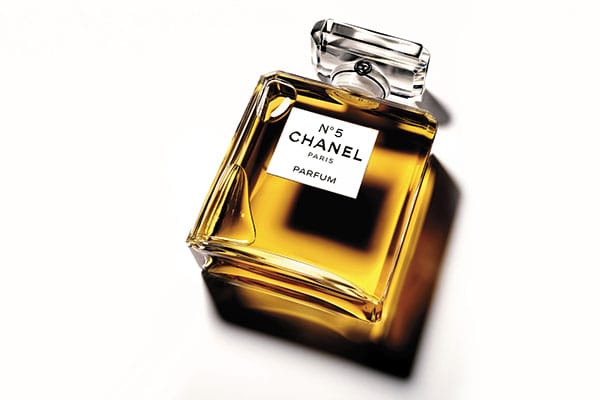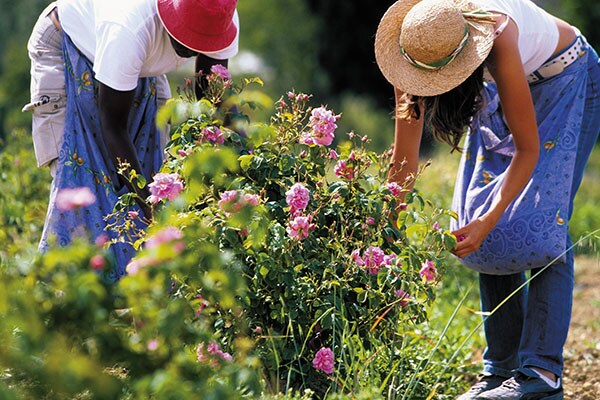Chanel no 5: The Scent of a Woman
Tracing where Chanel No. 5 is born


It is a very particular French summer morning, the kind where the sky is so blue that it looks as if it has been inked into exaggeration. The air is fresh, the sun is beautifully mild as it delicately highlights the picturesque drive from Nice to Grasse. I find myself inhaling deeply over and over again. I don’t want to miss the first sign or smell of the May Rose. After all, my job today is to visit the perfume capital of the world and see how the iconic fragrance Chanel No 5 gets its distinctive notes. The amber-coloured liquid with its “art-deco inspired, classic square-faceted” design holds a special place in my life. It was my grandmother’s favourite perfume. A bottle always lay on her dressing table. Today, I don’t leave home without generously dousing myself with it. Somehow, Chanel No 5 manages to remind me of my childhood even as it makes me feel all grown up and womanly. I am not in a minority. Every 30 seconds, a bottle of Chanel No 5 is sold somewhere in the world. Rather impressive for a product that was launched in 1921.
Its most discernible ingredient is being gathered today. In the early hours of the morning, when the May Rose blooms. Done the old-fashioned way by pickers who have worked in Grasse for decades, it is a delicate, time-consuming process. Each flower is twisted off gently, never snapped, one by one. And when the bag is full, the precious cargo is taken to the factory and processed within the hour. Standing in the fields you can feel the fragrance clinging to your clothes. It is magical. The blooms have an uncontained beauty, nothing like the manufactured, almost antiseptic, roses you see in flower markets in big cities. With its clean classic lines, the bottle is designed to look like a whiskey decanter
With its clean classic lines, the bottle is designed to look like a whiskey decanter
We head to the refinery to see how the concentrate is made. I am almost disappointed at how industrial the refinery looks—you would think the factory that makes this epic fragrance would have more colour, more character. And then you are reminded that fragrance making is a science. And belongs to men in lab coats. Like Ernest Beaux, the creator of Chanel No 5. As a teenager he apprenticed as a laboratory technician in the soap works of A Rallet & Company (Russia’s premier cosmetics, soap and perfume manufacturers at the turn of the 20th century). The roses are machine-pressed in a giant container and the concentrate that is extracted, I am told, is more expensive than gold. The residue, the roses sans the fragrance, has a strangely ripe and unpleasant smell. I think there is a life lesson here, but at the moment all I can think about is the woman behind this perfume because it has hit me that this, here, is the story of her life.
One of the first trips I made to Paris on work was for an introduction to the house of Chanel. We were taken to her apartment, 31 Rue Cambon. A three-storeyed building in the first arrondissement, it has the boutique on the ground floor. The first floor is reserved for private showings and custom fittings. The third floor is where Karl Lagerfeld sits—and you are not allowed to visit. But it is the second floor where you get to meet “Coco”. Her apartment is preserved so pristinely it seems as if she has just left the room. You imagine that if you looked out of the window you would see her crossing the street to enter her suite at the Ritz in Place Vendome. Mademoiselle never lived here—she only came here to create—and preferred to have her quarters in the hotel. Since she worked across the road, she always took the shortest route home—through the kitchen’s back entrance. On that first trip, even though it is no longer permitted, the Ritz allowed us to walk in her shoes. From the quilted cushions to the camellia flower to the intertwined Cs on the chandeliers, you can see the palette of her inspiration. The most amazing thing is how her legacy is kept alive. Her team speaks of her as if she was still there. Not in a creepy Ghost kind of way, with her watching over your shoulder. It’s with reverence for what this unique woman managed to achieve.  The May rose is grown in Grasse, the perfume capital of the world
The May rose is grown in Grasse, the perfume capital of the world
I love reading about Coco and her feminist ways. She enjoyed flouting convention. She cut her hair when women were supposed to wear it long. She lit up with insouciance. She embraced the sun when a tan was a fashion faux pas. She freed women from all the tedious boning and corsetry of the time. And yes. We can thank her for our three favourite staples: The little black dress. The shoulder strap bag. And the red lipstick. She wasn’t a charmer but she was charismatic. Most of all she was human. History will always remember her for her genius. And her rivalry with Christian Dior. After the war, Monsieur Dior introduced the “New Look” which brought back the nipped in waist and full skirt. Wildly exaggerated and extravagant it stood for everything Chanel despised. She called off her 15-year retirement and returned to fashion at the age of 70. Fierce and feisty, she is one of the most quotable women to date. I guess French women never do go out of style. Particularly not this one.
The writer was editor-in-chief of Elle India for 13 years (till Dec 2012), a role in which she influenced fashion and lifestyle
First Published: Jun 13, 2014, 06:19
Subscribe Now(This story appears in the Jan 08, 2010 issue of Forbes India. To visit our Archives, Click here.)